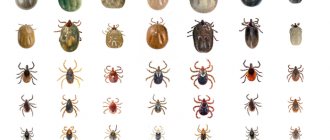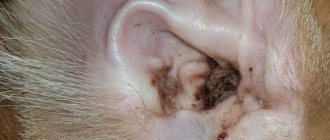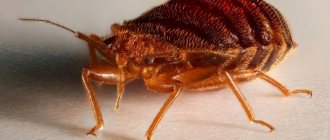Characteristics of the disease and its danger
3-6 days after the first signs and symptoms of piroplasmosis appear in dogs, treatment is ineffective. This blood parasitic disease is caused by Babesia (pyroplasmas), intracellular parasites that attack red blood cells (erythrocytes). Their waste products poison the body, and constant growth destroys cells.
Red blood cells are courier cells. They are responsible for the delivery of oxygen and the absorption of carbon dioxide. When they are destroyed en masse, hypoxia (lack of oxygen) occurs, which can lead to brain death.
Trying to compensate for the excess of carbon dioxide and the lack of oxygen, the organs of the respiratory and cardiovascular systems begin to wear out. The animal may die due to oxygen deficiency.
Due to intoxication, the liver, spleen and kidneys responsible for metabolism are affected. The destroyed cells clog the kidney tubules, forming blood clots.
What is piroplasmosis?
The causative agent of the disease is a single-celled form of the parasite Piroplasma canis, localized in red blood cells, gradually multiplies and destroys them. At the same time, up to 16 piroplasmas can be present in red blood cells, but more often – 2-4.
Intermediate hosts in whose bodies the piroplasm reproduces asexually are representatives of the canine family. The definitive hosts and vectors of babesiosis are ixodid and argasid ticks, which are active during the warm season from April to September. In the southern regions, where spring comes from the end of February and March, piroplasmosis begins to “rage” earlier.
Life cycle of the pathogen
Associated with the change of two hosts – a tick and a dog. The latter become infected by an insect bite during walks in nature. Babesia, penetrating into red blood cells (trophozoites), feed on hemoglobin and multiply by simple division, forming two daughter cells. Merozoites are drop-shaped and localized in the central part of the erythrocyte.
In case of extensive invasions, several pairs can be found (up to Babesia in one erythrocyte. By destroying the membrane of red blood cells, Babesia enter the bloodstream and reintroduce into a healthy cell, completing the cycle and turning into trophozoites.
Babesia in one erythrocyte. By destroying the membrane of red blood cells, Babesia enter the bloodstream and reintroduce into a healthy cell, completing the cycle and turning into trophozoites.
Piroplasmosis occurs seasonally, but in recent years there have been abnormal outbreaks of ixodid tick activity due to climate change. The dog requires protection from the first thaw until the onset of pre-winter frosts; ixodes are active only in the warm season. Contrary to belief, a tick can bite a dog even in a metropolis park. Previously, piroplasmosis was considered a disease only of village pets or dogs taken outside by their owners.
Ixodid ticks do not sit on trees and do not “jump” from there onto a person or animal. Thick grass and bushes pose a danger; in areas of widespread localization, ticks can be observed actively moving along trampled grass or through the air (with the wind). In recent years, the area of distribution of piroplasmosis has expanded. Now outbreaks of protozoal hemolytic disease are recorded in regions with cold climates (Center of the Russian Federation).
The first signs of piroplasmosis in dogs appear 4-20 days after the bite, which is how long the incubation period of babesiosis lasts. Symptoms are accompanied by fever, hemolysis (destruction) of red blood cells, urine in dogs with piroplasmosis becomes red, and hemoglobinuria develops.
Fact! Even if you independently remove a tick from a pet, it is impossible to determine whether the insect is infected or not. Therefore, when ixodes are active, the dog should be treated with repellents and wear protective collars.
Development cycle - from bite to manifestation
Outbreaks of the disease are more often recorded in the spring and autumn seasons. At this time, ticks awaken - the main carriers of Babesia in dogs.
How does infection occur?
Intermediate hosts of piroplasmas are ixodid ticks. They cling to animals in the tall grass and feed on their blood. During a bite, the parasite makes a neat cut with its proboscis, penetrating the blood channel. To relieve pain, he secretes a special anesthetic. After saturation, part of the drunk blood, along with Babesia-infected saliva, is injected back. This process takes from 1 to 2 days.
Not all ticks are infected with intracellular parasites, but it is safer to consider each of them potentially dangerous. If a tick is found on the dog's body, it is recommended to undergo a full laboratory diagnosis.
Stages of disease development
Pyroplasmas are dangerous only for the canine family. Their life cycle consists of several transformation stages:
- sporozoites transmitted along with the saliva of parasites;
- trophozoites, developing inside red blood cells and feeding on hemoglobin;
- merozoites, formed during the division of trophozoites and destroying red blood cells.
After the destruction of one of the red blood cells, the parasite leaves the cell and goes into the bloodstream in search of new ones. Macrophages are responsible for removing destroyed cells, but over time they cease to cope with their task. This leads to serious intoxication of the body.
Length of incubation period
On average, the incubation period of piroplasmosis in dogs is 7-10 days. Sometimes the first symptoms appear only 3 weeks after infection, and sometimes – already on the 3rd day or a couple of hours after the tick bite. The duration of the incubation period is affected by:
- number of ticks bitten and sporozoites penetrated;
- availability of vaccination against the disease;
- the age and state of the animal’s immune system.
Symptoms develop after the appearance of a sufficient number of trophozoites and merozoites. They actively destroy red blood cells, worsening the general condition of the sick quadruped.
Can an animal get sick again?
Pets who have recovered from the disease are still vulnerable. The immunity gained after an illness lasts no more than six months. After re-infection, less severe symptoms are observed. The pathology occurs in a chronic form.
What kind of disease is piroplasmosis?
Piroplasmosis (babesiosis) is one of the most dangerous diseases in the canine family. Its causative agents are microorganisms from the genus Babesia , transmitted by ixodid ticks. It is not surprising that the peak of the disease occurs in spring , the time when ticks are active. If symptoms are detected, the animal should be immediately shown to a veterinarian. If treatment is not started on time, death can occur within a few days.
The main symptoms of the disease include:
- Refusal of food and walks.
- Temperature rise above 40ºC.
- Vomiting or diarrhea.
- Rapid breathing and heart rate.
- Darkening of urine.
These symptoms do not directly indicate piroplasmosis, but they help the owner understand that not everything is okay with the pet.
On the 3rd day, more significant signs begin to appear:
- Change in color of the mucous membranes of the oral cavity.
- The animal refuses to eat and drink.
- Motor activity is completely absent.
- Breathing and heartbeat are very weak.
- Convulsions or paralysis of the hind limbs.
Piroplasmosis can only be confirmed using a biochemical blood test . Sometimes a urine test for the presence of hemoglobin and a serological test may be required. All dogs are at risk, regardless of age and place of residence.
Can babesiosis be transmitted from dogs to other animals and humans?
Blood parasites are transmitted only through ticks. Another form of transmission is possible through blood transfusion of a sick animal. Babesia is not dangerous for humans, so pets are cared for without special protection.
If there are other dogs living at home, it is worth isolating the infected pet - but rather for its own good, to protect it from unnecessary fuss. It does not act as a source of disease for its relatives.
Signs and manifestations in different forms
The severity of the course depends on the form of the disease. It is easiest to identify the symptoms of acute pathology, accompanied by vivid symptoms. By making a diagnosis at an early stage, complications can be avoided.
In chronic form
Chronic piroplasmosis develops in dogs that have recovered from the disease and adult animals with strong immunity. Its symptoms are vague, so the chronic form is difficult to distinguish from other diseases. After infection it is noted:
- temperature rise followed by normalization within 2 days;
- alternation of the usual state with lethargy and apathy;
- weakening of the muscles of the hind legs and paleness of the mucous membranes, characteristic of anemia (anemia);
- periodic loss of appetite;
- diarrhea or constipation.
This condition lasts up to 2 months, so you should not test your pet’s strength. If you suspect anemia, gastrointestinal upset or any behavioral changes, contact your veterinarian immediately.
In acute form
An acute course is typical for unvaccinated small or elderly pets. The disease is accompanied by the following symptoms:
- lethargy, apathy, fatigue, refusal to eat and walk;
- temperature rise to 40-42 °C;
- redness and then darkening of urine up to black due to massive death of red blood cells;
- increased heart rate and breathing due to lack of oxygen;
- vomiting and diarrhea (greenish or bright yellow), dehydrating the body.
If there is no help within the first 3 days, the condition worsens. The mucous membranes become pale or yellow. The heart beats more and more often, but its beats gradually weaken. The patient loses a lot of weight and stops performing physical activity. Partial or complete paralysis of the limbs develops, accompanied by convulsions. Soon after this the animal dies.
Piroplasmosis in dogs: symptoms and treatment
Piroplasmosis is a serious disease that is caused by the bite of an ixodid tick. Another name for this disease is canine babesiosis, “in honor” of the causative agent - the protozoan parasite Babesia. This is a very dangerous disease, the symptoms of which are important to know in order to suspect something is wrong in time and begin treatment as quickly as possible.
Babesia multiplies in erythrocytes (red blood cells), causing serious health problems for your pet. Lack of treatment leads to severe complications and death. If medical care is provided in a timely manner, the prognosis is favorable, so at the first symptoms of the disease you should immediately show the dog to a veterinarian.
Most often tick attacks occur in April-June and August-October. Keep in mind that this is peak activity. However, even in winter, a tick can attach itself if the parasite climbed into a warm place and survived. Therefore, inspect your pet as soon as it starts to get warm outside in the spring and until permanent snow cover is established in the fall.
Important! If you were in the village in winter, be sure to examine your pet. The dog could run into the barn and lie down in the hay (ticks can overwinter in it) or dig up the ground (ticks overwinter in the ground at a depth of 10-15 cm).
How does infection occur?
Infection with piroplasmosis occurs through a tick bite. Babesia enter the dog's bloodstream at the time of a bite with the saliva of a tick, continue to enter during blood sucking and cause the development of the disease. The incubation period of piroplasmosis lasts from 2 days to 3 weeks.
Previously, I talked about the dangers of ticks and how to properly remove a tick. Read through to avoid making mistakes.
The length of the incubation period depends on several factors:
- Age of the animal. Young dogs are most affected by the disease. But even for older people, the risk of the disease is quite high.
- Health status. Weakened animals that have undergone other diseases or operations shortly before infection are more likely to become infected with piroplasmosis.
- Duration of blood sucking. The longer the tick is on the dog, the greater the dose of infection it can inject into the blood.
- The number of infected parasites and piroplasms that have entered the blood.
- State of immunity. If your pet has already suffered from piroplasmosis, then he has developed a weak immunity to this disease.
- Conducting vaccinations. Vaccination does not guarantee 100% protection, but it will help develop immunity, which will make it much easier to treat the disease.
Symptoms of the disease in acute form
So, the most unpleasant thing has happened - your dog has been attacked by ticks. Monitor your pet carefully. Symptoms of the disease may vary depending on the form of the disease in a particular animal: acute or chronic.
The acute form is most common in dogs that have not previously been infected. Although it takes time for Babesia to begin to grow and reproduce, clinical symptoms of piroplasmosis appear fairly quickly. Usually, about 2-4 days pass from the moment of infection to the very first signs of the disease. However, there were cases when 3 weeks passed from the moment of the bite.
The first signs of the disease:
1. Increased body temperature is the first sign of the disease. Dogs have a higher body temperature than humans, and normally reaches 39 degrees. If the temperature rises to 40–42, then it’s time to sound the alarm. The name of the disease consists of two words: “pyro” - heat, fire, “plasma” - blood, that is, “hot blood”.
2. Darkening of urine. The urine darkens and blood appears in it. There have been cases where the urine turned black. This happens because Babesia multiplies in red blood cells, causing them to break down. Dead red blood cells are excreted in the urine, and darkening indicates their massive death.
3. Increased breathing. Red blood cells are responsible for transporting oxygen to internal organs and removing carbon dioxide. And since they die in huge numbers and very quickly, oxygen exchange is disrupted. As a result, anemia and oxygen starvation develops. To increase the amount of oxygen, the dog has to breathe frequently. As a result, the pulse quickens. All this increases the load on the heart. As a result, the animal’s behavior changes: the previously active, inquisitive dog quickly gets tired, becomes lethargic, apathetic, refuses walks, and loses appetite.
4. Diarrhea and vomiting are the result of general poisoning of the body. Vomiting leads to dehydration, which further weakens the dog's body.
These symptoms last 2-3 days. If you do not seek treatment from a veterinarian at this point, your pet’s condition will worsen significantly. At the same time, the disease progresses and new symptoms appear:
- Redness, yellowing or blue discoloration of the mucous membranes of the mouth and eyes, which is caused by impaired liver function and oxygen deficiency.
- The heartbeat is rapid and very weak, as the load on the heart increases greatly.
- The appearance of shortness of breath and difficulty breathing.
- Complete refusal of food, lack of motor activity, weakening of the hind limbs - all this is caused by the active destruction of the dog’s body.
- Partial or complete paralysis of the limbs, which is accompanied by convulsions.
If in this case you do not seek help from a veterinarian, the likelihood of death increases greatly. As a rule, death occurs 3-7 days after infection.
Chronic form of piroplasmosis
It is observed in dogs that have previously had piroplasmosis or have good immunity. With a chronic disease, the symptoms are very mild. Babesia are found inside the body but are inactive. However, if the dog’s body undergoes any changes, stress can activate the parasites, and this will lead to an acute form of piroplasmosis.
The main signs that indicate a possible disease are the pet’s constant fatigue and apathy.
This form is characterized by the following symptoms:
1. Apathy and melancholy, rapid fatigue.
2. Refusal to eat, as in the case of acute illness.
3. Weakness and lethargy caused by exhaustion of the body.
4. Diarrhea.
If you notice this condition of your pet, do not delay, but contact your veterinarian as soon as possible. The chronic form of piroplasmosis is quite rare. One of the signs of a disease that has become chronic is anemia, which only progresses over time.
Diagnostics
Don't try to diagnose yourself. Only a veterinarian, based on laboratory tests, can make the correct diagnosis and prescribe treatment. Since the symptoms of piroplasmosis are not always clearly manifested and are blurred, examinations are repeated after a few days. At the beginning of the incubation period, it is not always possible to detect Babesia in the blood.
Treatment
Just as you shouldn’t try to diagnose yourself, you shouldn’t treat the dog yourself. Such attempts will cause irreparable harm to the health and life of your pet. Therefore, contacting a specialist should be urgent, because the sooner you start treatment, the greater the chances of recovery.
Veterinarians are appointed:
1. Drugs to destroy the causative agent of the disease. All of these products are highly toxic and the wrong dosage can kill your pet. They cannot be used without a doctor's prescription.
2. Alkalinization of urine using intravenous sodium bicarbonate to support kidney function. The dog is also soldered with a soda solution or given drips with salt-containing medications.
3. Additional treatment with drugs to support the heart, hepatoprotectors, vitamins, glucose, diuretics and means to restore blood circulation.
4. Blood purification through filtration outside the body or blood transfusion.
Prevention
In this article, I already talked about how to protect your dog from ticks.
Since the use of most products (such as vaccines, tablets, sprays, drops) does not provide 100% protection against piroplasmosis, protect your pet from the carriers of the infection - ticks.
From the first warm days until the onset of cold weather, take care to protect your pet with a spray or drops on the withers. Buy a collar with a strip of active substance that causes the death of ticks that come into contact with the skin and fur. Examine your dog after each walk, especially carefully checking the ears, groin area, neck, and armpits.
Be attentive to your four-legged friend - your love and care will be the best protection against a dangerous disease.
Anton Koteikin, a consultant for the Samizoo.ru online store, was with you.
Diagnostics in a veterinary clinic
Treatment of piroplasmosis in dogs with drugs begins only after diagnosis. Both forms of the disease are curable if detected early, so vigilance and good response are required from the owner.
The symptoms of the pathology are similar to leptospirosis and distemper, so self-treatment is not allowed. To make a diagnosis, the veterinarian examines the four-legged patient, checks the symptoms noticed by the owner and conducts laboratory tests.
Analysis of urine
Destroyed red blood cells are removed from the body through the urinary system. When infected with blood parasites, hemoglobin is detected in the patient’s urine.
Blood analysis
A more accurate diagnostic method is a blood test. It includes 3 analyses:
- clinical, determining the level of hemoglobin, the level of leukocytes and erythrocytes;
- biochemical, revealing the presence of inflammation and the condition of internal organs;
- microscopic analysis of a stained smear to determine the presence of piroplasms.
During the incubation period, tests are often false negative. If the owner independently discovers a tick, and his pet suffers from clinical signs, the diagnosis is repeated after a couple of days.
Echinococcosis
Rospotrebnadzor distributed a leaflet reminding about the potential danger for humans of contracting echinococcosis from dogs. The memo was compiled as part of the preparation of a draft resolution on behalf of the chief sanitary doctor of Russia “On preventing the spread of echinococcosis in the Russian Federation.”
Related article: Do dogs get depressed? How people and their pets are related According to the department, a person can become infected with this disease through contact with sick animals, in particular dogs, when collecting and eating wild berries and herbs, as well as through consuming contaminated water. It is worth understanding that echinococcosis is essentially a parasitic disease. It is caused by tapeworms of the same genus. When infected, the larvae enter the liver; less often, they can move to the lungs and other organs. Against the background of their vital activity, cystic formations containing parasite larvae develop in the human body. As a rule, the disease is detected in the early stages using instrumental examination or during surgery. Moreover, parasites can live for decades before clinical signs appear in the human body.
Among the symptoms that indicate echinococcosis:
- jaundice;
- liver enlargement (determined by palpation or ultrasound);
- pain that radiates to the arm or back;
- a feeling of heaviness and compression on the right hypochondrium;
- dyspnea;
- cough;
- chest pain, etc.
It is worth understanding that the disease can be fatal, and often as a result of it a person is assigned a disability. You can avoid infection. It is enough to observe simple hygiene, i.e. wash your hands after contact with the dog, do not let it lick anything from your food, minimize situations when the dog licks its face or often stays on the sofa or bed of its owner, especially if it regularly does not undergo antiparasitic therapy.
Treatment regimen
The treatment regimen for piroplasmosis in dogs is aimed at destroying the pathogen, relieving symptoms and normalizing the condition. In severe cases of the disease, accompanied by excessive loss of red blood cells, the dog is filtered or given a blood transfusion.
Destruction of the pathogen
To destroy piroplasms, special medications are used, for which it is very difficult to calculate the dosage. Many of them are highly toxic, so self-treatment is excluded.
All antiprotozoal drugs are available in the form of injection solutions. To give a dog an injection, it is taken to a veterinary clinic or a veterinary nurse is called to your home.
Before using antiprotozoal drugs, it is necessary to suppress the autoimmune reaction and relieve allergic symptoms. Glucocorticosteroids, which are also prescribed by the doctor, cope with this task.
Adjuvant therapy
In case of severe intoxication and dehydration, the four-legged patient is given drips with Ringer's solution, glucose and sodium chloride. They normalize urinary function, facilitating the outflow of urine and the removal of toxic substances.
To restore damaged organs, the following is prescribed:
- hepatoprotectors (Karsil, Silibor), which improve the condition of liver cells;
- immunomodulators (Gamavit, Ribotan), stimulating the functioning of immune cells;
- vitamins B and C, which restore the natural number of red blood cells;
- injection solutions (Cordiamine, Lauritin) that normalize the nutrition of the heart muscle and lungs.
Patients with liver and kidney failure undergo plasmapheresis - blood purification through a filter. This procedure allows you to remove settled toxins and prevent the development of complications.
Patient care
During treatment, the dog is limited in physical activity and prescribed a gentle diet. The duration of walks is reduced to 10 minutes, but their frequency is increased to 4-6 times a day.
Soon after taking the medication, the dog returns to normal activity. This improvement is deceptive. Therapy takes up to six months, so do not stop using the medications until you receive permission from your veterinarian.
Features of feeding
The recommended diet is aimed at reducing the load on affected organs and regenerating damaged tissues. Its principles include:
- Fractional meals
. Reduce the usual portions and increase the frequency of feedings to 5-6 times.
- Increasing the number of meat products
. The main task is to increase hemoglobin.
- Use of medicinal feed
. Animals that are not fed “naturally” are fed dry pellets soaked in water. A separate series of veterinary lines contains many nutrients and is lower in calories.
- Warming food to room temperature
. Do not serve food from the refrigerator or immediately after cooking.
- Grinding food
. Offer your pet liquid porridge and meat, ground with vegetables. Eliminate cabbage from your diet, which causes increased gas formation.
To restore the intestinal microflora, the doctor may recommend a course of antibiotics or stop using fermented milk products. If kidney damage is severe, protein foods are reduced or completely eliminated from the diet. To track the results and possible adjustments to the diet, you need to take tests monthly.
Predictions and consequences
With timely treatment, the survival rate is 95%, and with late treatment it sharply decreases to 5%. The prognosis depends on the degree of damage to internal organs and systems. The animal can be saved without complications even at a late stage.
Possible negative consequences are caused not only by the pathology itself, but also by toxic drugs used in therapy. Four-legged patients often develop:
- lifelong anemia;
- pancreatitis;
- renal or heart failure;
- allergy;
- toxic hepatitis;
- inflammation of the pancreas.
The kidneys are most often affected, since, unlike the liver, they are not capable of regeneration. Prolonged hypoxia damages brain cells.
The pathology is dangerous for lactating and pregnant females. During treatment, it is recommended to interrupt feeding and have an abortion. Puppies from an infected mother are often born dead or with serious abnormalities.
Prevention of babesiosis
Prevention of the disease consists of vaccination and antiparasitic treatment. After each walk during periods of increased tick activity, carefully examine your pet. Pay attention to hard-to-reach places: tail, ears, armpits, groin area and paws.
Vaccinations
Vaccination is carried out only on healthy animals. During pregnancy, lactation or recent illness, vaccinations are contraindicated.
The vaccine does not provide 100% protection, but it can weaken the course of the disease and prevent the development of complications. The immune response is formed after the second vaccination and lasts from six months to a year.
The disadvantage of this type of prevention is represented by its advantage. Weak symptoms in a vaccinated animal after infection interfere with the timely determination of the pathology. Anti-tick medications are used as additional protective measures.
Piroplasmosis: a reminder for the breeder
Babesiosis affects dogs of all breeds and ages. Even miniature pets that move exclusively in the arms of their owners and prefer the cat litter box instead of walking, become the target of a tick attack. Ixodes travel well on human clothing. Therefore, after country promenades during the tick season, you need to carefully examine yourself and your clothes for the presence of dangerous insects.
Puppies, purebred individuals, and dogs under 3 years of age are more seriously ill.
The incubation period of piroplasmosis is on average from 2 days to 2 weeks, which is exactly how long Babesia needs to multiply in the pet’s body and cause the destruction of red blood cells.
Without treatment, the dog dies; the danger is posed by the babesias themselves, which actively inhabit red blood cells, and their waste products. They are very toxic to the body.
Fact! If the animal does not receive specific treatment within 3-4 days after the first signs of piroplasmosis appear, death occurs.
Features of piroplasmosis in dogs:
- Not all ticks are dangerous, but only those with Babesia (pyroplasma).
- Ixodes, which causes viral encephalitis in humans, are not dangerous for animals.
- Piroplasmosis cannot be infected by humans or other animals not included in the risk group for babesiosis.
- To identify the disease, a blood test is taken for piroplasmosis. The smear is made from peripheral blood taken from the ear or fingertip.
Direct confirmation of the disease is the detection of Babesia in a smear. However, the results of initial analysis are not always reliable. With small infestations or incorrectly taken blood, Babesia may not come to the attention of the researcher.
To transmit a parasitic microorganism, a tick must adhere well to the skin and hang there for at least a day. Therefore, after walks, you need to carefully examine your pet; ixodes stick to soft areas: behind the ears, on the face, in the groin, and less often in the anus area.
Consequences of the introduction of Babesia into the dog’s body:
- destruction of red blood cells;
- anemia (anemia);
- shortness of breath, general weakness.
The severity of the disease is determined visually by the pallor of the visible mucous membranes and a blood test. The destruction of red blood cells can be stopped if a medicine for piroplasmosis is promptly administered. With extensive damage to red blood cells, the consequences are unpredictable; only a blood transfusion will save the pet.











